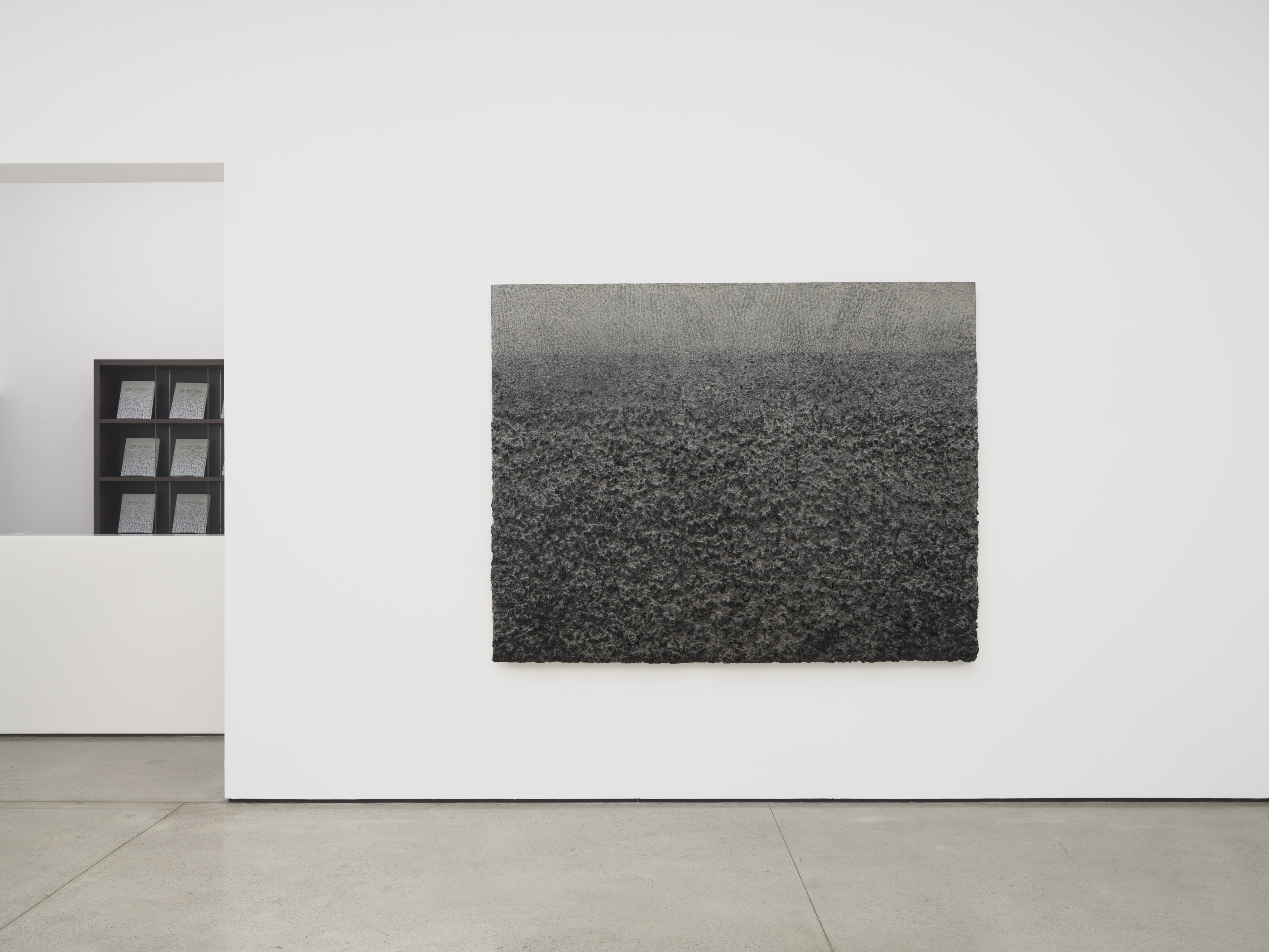Shows
Lee Jin Woo at White Cube


Lee Jin Woo
White Cube
Hong Kong
Jun 1–Sep 7
A core doctrine of Mahayana Buddhism, as articulated in the Heart Sutra, posits that “form is emptiness, emptiness is form.” If all forms are impermanent, conditionally arisen, and deprived of ownership, then Buddhism suggests that any expressed phenomenon we encounter lacks inherent existence—materiality entirely contingent upon our external perception. For Korean-born, Paris-based artist Lee Jin Woo, the practice of ritualistic repetition and restraint serves as a process of spiritual purification to preserve the emptiness of form. Lee transforms the materials of hanji (traditional Korean paper) and charcoal into abstractions in a physical process of deconstruction that obliterates the human ego in pursuit of self-connection.
Comprising 17 untitled works, Lee’s debut solo exhibition in Hong Kong at White Cube was a testament to his 30-year odyssey of rigorous practice to develop a technique of concealment and invalidation. Lee initially sets down a backdrop of ground charcoal mixed with adhesive on linen, which he overlays with sheets of hanji. By repeatedly beating and scraping the surface of his canvas with an iron brush, the friction between these substances gradually coalesces to form an accumulation of dense layers, constituting reinvigorated forms of objecthood. The grinding of charcoal serves as a metaphor for Lee’s nullification of his position as creator—a gesture of self-denial and authorial erasure accentuated by the repeated application of hanji to smother his initial compositions on canvas. The dynamic interplay between both mediums is given space to organically unfold, culminating in a final form that transcends the confines of the artist’s control.
Across the gallery’s ground and first floors Lee’s renowned monochromatic surfaces emerged as a tactile tableaus of the natural world reminiscent of mineral aggregates, sedimentary structures, and glacial terrains, seemingly extending the confines of the exhibition space into an endless expanse. One of Lee’s untitled works from 2023–24 resembles the aftermath of an act of destruction; dark clusters gather and cloak the canvas in coarse, soot-like masses, their tangible materiality inducing a response more predisposed toward tactile sensation than mere visual perception. In another work, the scattered placement of charcoal enables threads of milky-white hanji fibers to emerge through its wider interspaces, conjuring a craggy cliff top marked by jagged striations and shallow crevices.

Lee’s practice draws from a loosely affiliated set of Korean artists from the 1970s whose styles of minimal abstraction came to be known as Dansaekhwa (meaning “monochrome” in Korean). Using reductive palettes and motifs, these artists sought to dispel individualistic interpretations of reality through self-discipline in technique, cultivating an aesthetic philosophy that authentically encapsulates the emptiness of form. Freelance curator, art critic, and artist Yoon Jin Sup explains how “the mindful production of Dansaekhwa as a process can be considered a type of performance, fully integrated and visible” in the artist’s work. The repeated motions inherent in Lee’s creative process represent an act of humility, a laborious endeavor demanding vigorous physical effort, redefining the artist’s role from that of a sophisticated conceptualist to a hands-on craftsman. Lee’s methodology empties his work of individual thoughts and personal reflections, granting his viewers complete autonomy to encounter their own emotional responses. Each canvas pulsates as breathing, living matter.
While the darkness of charcoal stands as a distinguishing feature in most of Lee’s works, one rendered in oceanic blues, situated at the end of a staircase leading to the gallery’s first floor, offered a refreshing perspective into Lee’s technique. Resembling a cascade of water trickling down a rocky precipice, or a crystalline layer of frost solidifying atop an icy brook, Lee’s painting exudes a coolness that gently coaxes viewers out of the depths of their contemplation.

%202.jpg)
The exhibition’s final part featured four ink-on-paper experimentations comprising calligraphic inscriptions directly etched onto hanji. These phrases are repeatedly superimposed until all text becomes indecipherable—a gradual effacement akin to self-erasure. The final image is less a palimpsest and more analogous to a mass of gray fog, in which all expressions are subsumed and lost, swallowed up in its visual density.
Tactile, repetitive, dark, and formless, Lee’s minimalistic visual vocabulary surges with profound resonance. Anchored in the tenets of neutrality and abstinence, his artistry transformed the gallery into a quiet refuge for introspection while evoking a vast expansiveness—both soulful and estranging. Rich in materiality and devoid of narrative, Lee’s canvases culminate as a candid embodiment of the empty form which, as beholders, we must endow with our personal truths.
Mioie Kwok is an editorial intern at ArtAsiaPacific.







